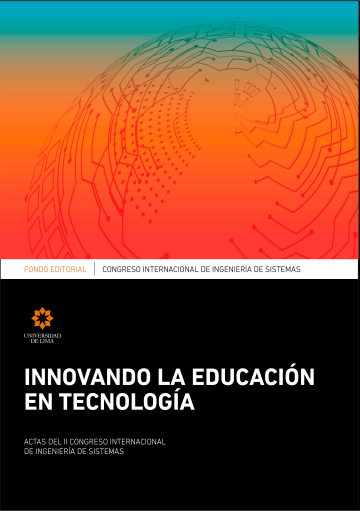Convolutional Neural Network for Detecting Endangered Exotic Birds
DOI:
https://doi.org/10.26439/ciis2019.5513Keywords:
object recognition, convolutional neural networks, wildlife tradeAbstract
In the last years, the rates of illegal wildlife trade have increased due to the lack of awareness for caring and preserving our ecosystem. Between the years 2000 and 2015, sixtyseven thousand seven hundred forty-nine (67,749) wild animals were illegally taken from Peru, including 29,591 exotic birds (43%), 26,951 amphibians (40%), 8,600 reptiles (13%) and 2,607 mammals (4%) valued at approximately USD 1,000. The proposal to significantly reduce these illegal acts is based on having an application that can identify the species attempted to be illegally traded. Such application will use the architectures of convolutional neural networks called VGGNet16, which will allow the correct identification of the animal. The present research used a database of real animals, obtaining an effectiveness of 89%.
Downloads
References
Barletta, F., Pereira, M., Robert, V., y Yoguel, G. (2013). Argentina: dinámica reciente del sector de software y servicios informáticos. Revista de la CEPAL, (110), 137-155. Recuperado de http://www.cepal.org/publicaciones/xml/1/50511/RVE110Yoqueletal.pdf
Carrión, A. (2017). Tráfico de fauna silvestre en estado de emergencia. El Comercio. Recuperado de
https://elcomercio.pe/wuf/noticias/trafico-fauna-silvestre-emergencia-402805-noticia/
InteractiveChaos making things simple. (s. f.). InteractiveChaos making things simple. Recuperado de https://www.interactivechaos.com/python/function/traintestsplit
Karpathy, A., Toderici, G., Shetty, S., Leung, T., Sukthankar, R., y Fei-Fei, L. (2014). Largescale video classification with convolutional neural networks. 2014 IEEE Conference on Computer Vision and Pattern Recognition, 1725-1732.
López Tarabochia, M. (2016). Perú: Rescatan 25 aves silvestres que iban a ser comercializadas ilegalmente en Europa. Revista Mongabay. Recuperado de https://es.mongabay.com/2016/12/peru-aves-trafico/
Marques, A. C., Raimundo, M. M., Cavalheiro, E. M. B., Salles, L. F. P., Lyra, C., y von Zuben, F. J. (2018). Ant genera identification using an ensemble of convolutional neural networks. PLoS ONE, 13 (1).
Motta, D, Santos, A. Á. B., Winkler, I, Machado, B. A. S., Pereira, D. A. D. I., … Badaró, R. B. (2019). Application of convolutional neural networks for classification of adult mosquitoes in the field. PLOS ONE, 14 (1), 1-18.
Musso, D, Rodriguez-Morales, A. J., Levi, J. E., Cao-Lormeau, V.-M., y Gubler, D. J. (2018). Unexpected outbreaks of arbovirus infections: lessons learned from the Pacific and tropical America. The Lancet Infectious Diseases, 18(11), 355-361. doi:10.1016/S1473-3099(18)30269-X
Oquab, M., Bottou, L., Laptev, I., y Sivic, J. (2014). Learning and transferring midleve image representations using convolutional neural networks. 2014 IEEE Conference on Computer Vision and Pattern Recognition, 1717-1724.
Quevans, N., Falcón, N. y Elías, R. (2014). Fauna silvestre y productos derivados decomisados durante el período 2000-2007, Lima-Perú. Salud y Tecnología Veterinaria, 1, 14-18. doi:10.20453/stv.2013.105
Rosebrock, A. (2018). Keras y redes neuronales convolucionales (CNN). Pyimagesearch. Recuperado de https://www.pyimagesearch.com/2018/04/16/keras-and-convolutional-neural-networks-cnns/
Rossius, S. (2013). Reconocimiento de objetos mediante WebCam en tiempo real (Doctoral dissertation).
Serfor. (2017) Estrategia Nacional para reducir el tráfico ilegal de fauna silvestre en el Perú 2017-2027 y su plan de acción 2017-2022. Recuperado de https://www.serfor.gob.pe/wp-content/uploads/2017/09/PRESENTACION-DE-LA-ESTRATEGIANACIONAL-PARA-REDUCIR-EL-TRAFICO-ILEGAL-DE-FAUNASILVESTRE.pdf
Serfor. (2016). Guía Identificación y cuidados iniciales de animales silvestres decomisados o hallados en abandono. Recuperado de https://www.serfor.gob.pe/wp-content/uploads/2016/08/Guia-de-identificacion-final12ago.pdf
S. R. (2013). Reconocimiento de objetos mediante WebCam en tiempo real. Universidad Politécnica de Valencia.
Tobías, L., Ducournau, A., Rousseau, F., Mercier, y G., Fablet, R. (2017). Convolutional Neural Networks for object recognition on mobile devices: A case study. 2016 23rd International Conference on Pattern Recognition (ICPR), 3519-3524.
Zeiler, M. D., y Fergus, R. (2014). Visualizing and understanding convolutional networks. European conference on computer vision, 8689, 818-833.


